North Palisade via The U-Notch Couloir
Technical Alpinism in the Heart of the High Sierra
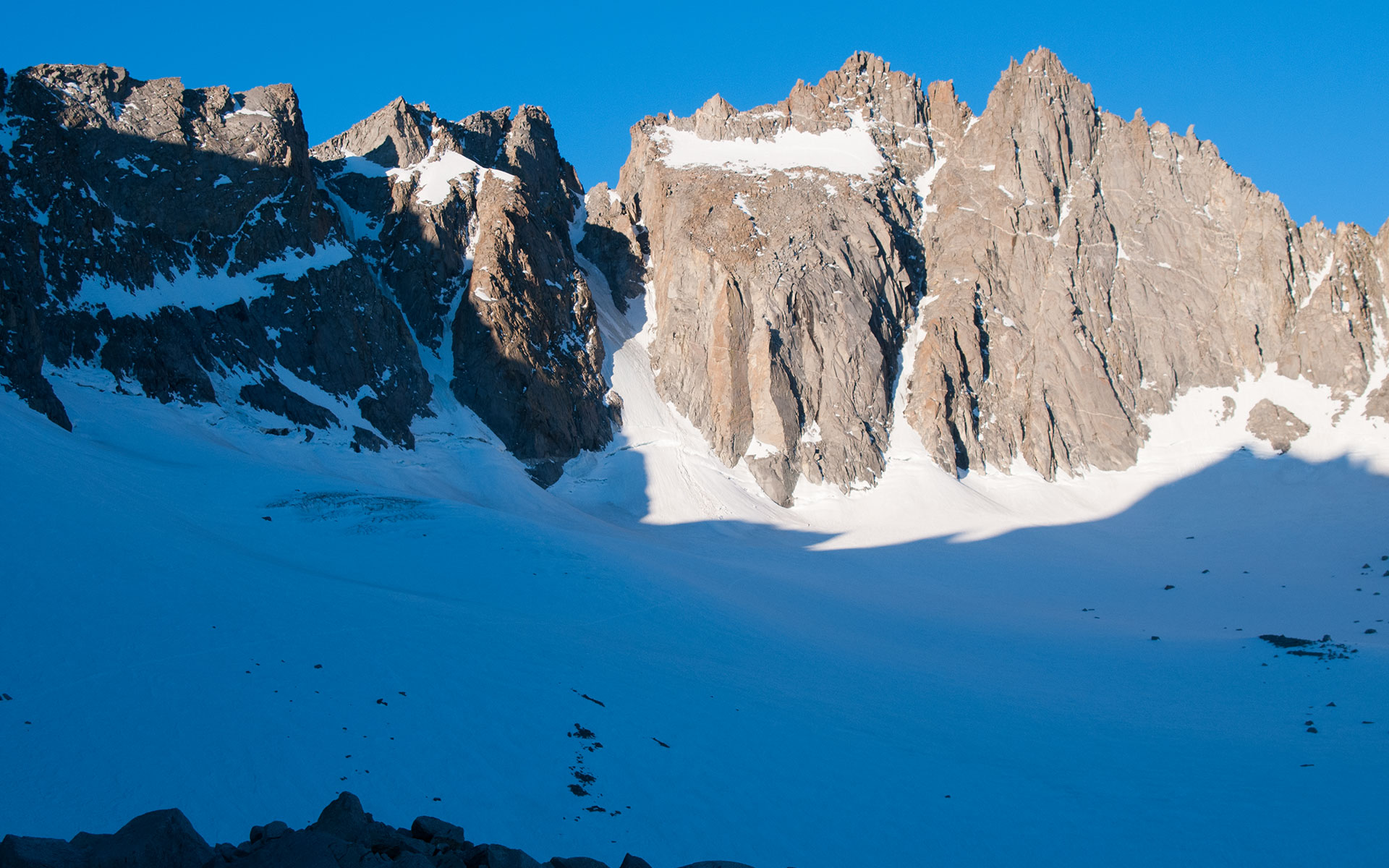
North Palisade, California — I am standing outside the Country Kitchen in beautiful Big Pine, California when Neil Satterfield drives up in a dusty old Subaru and slides out to greet me.
Tall, tan, and fit, Neil looks exactly like you'd expect a mountain guide to look: rock-solid. Along with fellow guide and co-owner Howie Schwartz, Niel runs Sierra Mountain Guides, a Bishop-based company that guides climbers and skiers throughout the Sierra.
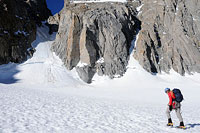
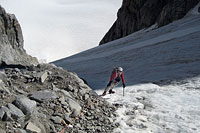
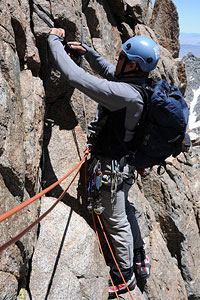
If your goal is to climb all of California's fourteeners, at some point you come to realize there is a break in the progression. It is possible, at first, to summit the easier peaks with little more than motivation, a map, and persistence.
Each time, you come away with a little more experience, allowing you to tackle the next summit on the list, and the next again. And then you come to North Palisade. Though it is not the highest peak in the range, North Pal may well be the symbolic apex of High Sierra mountaineering.
To reach North Palisade's 14,242-foot summit, you first cross a glacier, then a bona-fide bergschrund, then climb snow and ice in a 700' couloir, then tackle two pitches of Class 5 rock above.
While I'd acquired some confidence in my ability to scramble around Class 3 terrain in the Sierra, safely climbing and descending technical rock and ice was another realm altogether.
Without any roped climbing experience, it seemed foolhardy at the least to attempt something like North Palisade on my own. And so I began contemplating the possibility of climbing North Palisade with a guide.
I'd never tried a route with a guide before. To be sure, it seemed a little out of character for a dedicated soloist like myself.
But first and foremost I am a pragmatic climber, and if being stubborn meant staying home, I was willing to be flexible. I also knew there were potential benefits to be had. Working one-on-one with a trained professional would provide an outstanding opportunity to learn about roped climbing procedure and technique.
Call it an in-the-field clinic: I envisioned soaking up every possible bit of knowledge from my guide, learning the best, most current techniques on a wide range of subjects: setting protection, rappels, footwork, gear. There was also the issue of safety. If I was going to enter as risky a world as high-alpine rock climbing and mountaineering, I wanted all the odds in my favor.
I wanted to ensure, as much as possible, that I'd have a safe and positive experience, and that at the end of it I'd be coming home if not smiling at least in one piece. Time passed, and as I usual I got distracted by one project or another. Just as it began to seem as if I'd never find the right guide for my North Palisade objective, a funny thing happened: my guide found me instead.
Sierra Mountain Guides
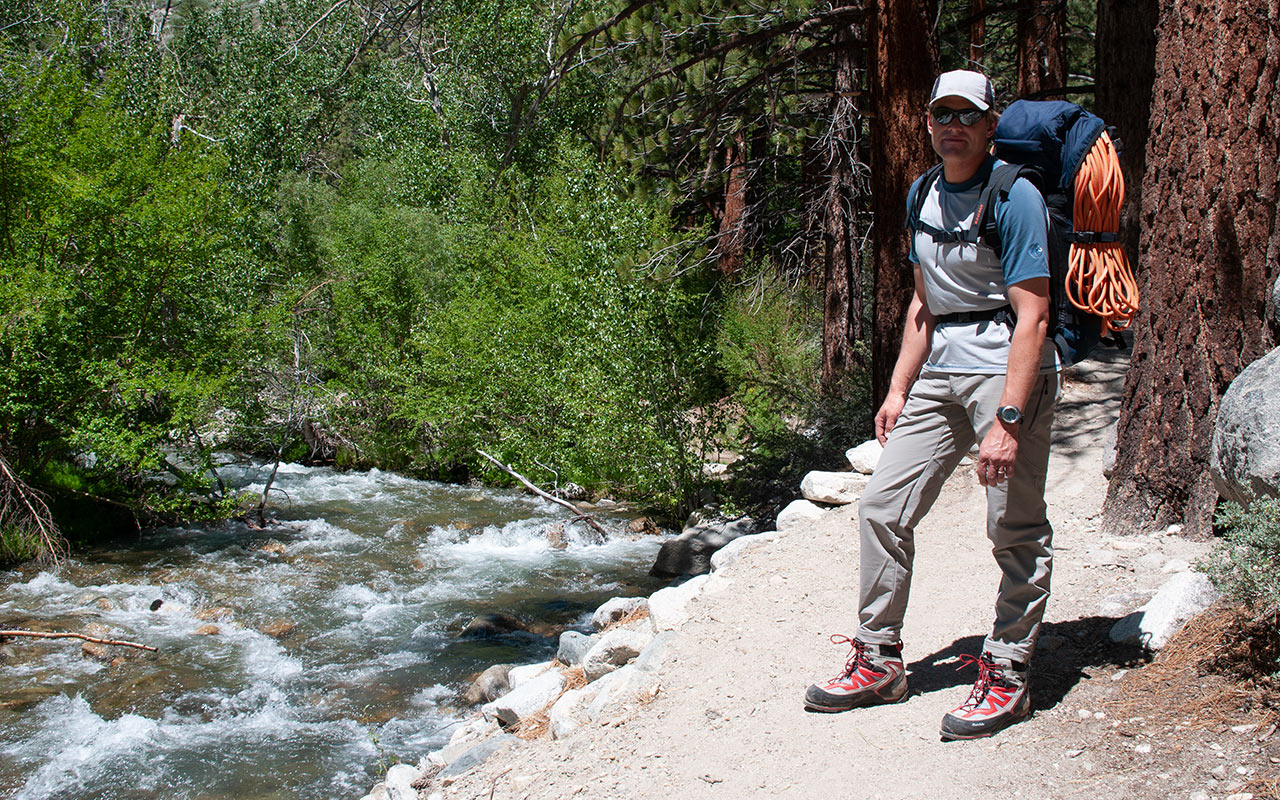
Neil Satterfield
Shortly after I skied Lone Pine Peak's East Couloir, I received a note of salutations and introduction from a company called Sierra Mountain Guides. The timing was perfect.
All my Sierra books were on the nightstand, and I'd been repeatedly paging through them looking for interesting summer projects. From that first email Neil and I now find ourselves at the front end of a joint venture to climb one of the most classic routes in the Sierra: North Palisade via the U-Notch.

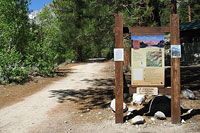
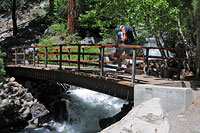
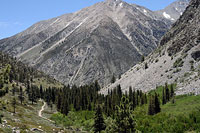

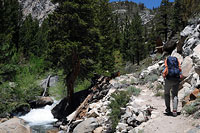
We shake hands and head inside the Country Kitchen for a pre-trip fuel up on eggs and hash browns. Once we're seated, Neil begins by asking what my expectations are.
Hmm...I'm a bit stumped by the question.
In truth, I'm a little nervous. I'm worried about my lack of technical climbing experience, my lack of formal mountaineering training, my overall physical conditioning (which is currently far from elite), my desire to climb well in the company of such a highly trained and skilled mountaineer.
All this plus the fact that I've never been on a guided climb mean I'm about to dive into an entirely new world. I really don't know what to expect—and maybe that's the starting point to answer Neil's question.
I'd like to learn as much as possible about technical climbing, rope work, ice climbing, glacier travel. And finally, I hope to make the summit and come back down in one piece, so as to write about the experience and possibly inspire others to take part in such inexplicable ventures.
The day is already warm when we arrive at the end of Glacier Lodge Road, elevation 7820'. We pack our gear and hit the trail, with Neil setting a comfortably modest pace alongside the rushing water of Big Pine Creek.
Finding a good guide is perhaps not as straightforward a matter as you might imagine. In California, professional guiding is regulated separately by each individual forest jurisdiction, without any standardized training or licensing requirements.
In contrast, the Sierra Mountain Guides company puts special emphasis on training and certifying its guides. Neil has just completed a three-year effort to earn UIAGM/IFMGA guiding certification in skiing, rock climbing, and mountaineering. It's obvious, even here in the early going, that Neil takes his responsibilities as a guide very seriously.
Being a good climber does not necessarily make one a good guide, he says. I see already that Neil is very much interested in ensuring the quality of my experience on this adventure. He is committed to being flexible, wanting to make sure that what he's doing will mesh well with my own personal climbing style.
Neil is also an avid backcountry skier who wants to ski many of the same technical winter routes that I've been eyeing. We talk for a while about the inherent contradictions of our sport—especially that always dicey matter of risk versus reward. We both talk enthusiastically about our families, and our passion for fatherhood.
We fearlessly talk politics and the price of oil before returning to the subject at hand: California mountaineering. Neil is obvious in his love for the Sierra and hiking and climbing. Technically he's at work, of course, but even so he can't help but stop now and then to admire a nearby arete, or an alpine meadow, or just the bright blue sky overhead. Onward we go.
Big Pine Lakes
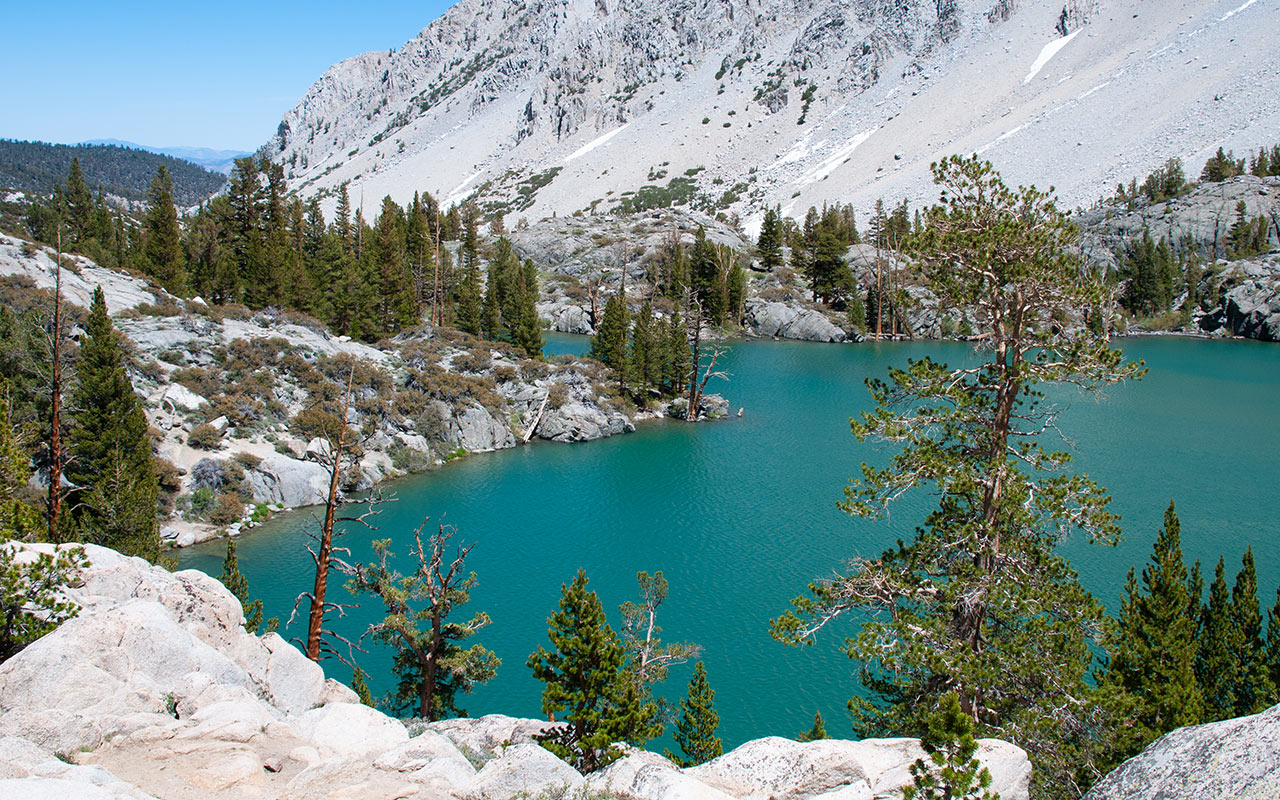
Evidence of glaciation past and present abounds in the Palisades region, including an impressive system of moraines and lakes above 10,000 feet. Neil and I take a break on a granite berm overlooking Big Pine Lakes.
We eat a quick snack and talk about possible campsites. The trail ahead makes a meandering loop to the north, but a shorter alternative exists in the form of a snow-covered gully beneath Temple Craig and Mount Gayley. Camping higher would place us on the edge of the Palisade Glacier, allowing quick access to North Palisade tomorrow.
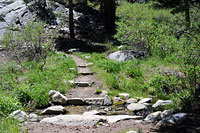
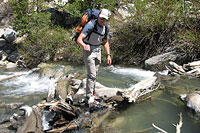

But carrying our fully-loaded packs up another 2000' hardly sounds like fun. Moreover, based on my body's reaction to the day's heat, effort, and our present elevation, I can already tell that sleeping lower will be a far more comfortable option.
That settles it: we agree to camp near Third Lake. We'll make up lost time tomorrow with an invigorating 3:30 a.m. start.
Neil leads the way off-trail and into a thicket of woods. Soon, we come to the first real adventure of the trip: a stream crossing.
Eyeing the loosely-piled logs bridging fast-moving water, I find myself wondering whether this constitutes some sort of climbing fitness challenge orchestrated by my guide:
Fall in here and No Soup for You!
Regardless, Neil and I successfully navigate the shifting log bridge in our heavy packs with only a minor bobble or two.
My boots prove nicely waterproof. Now, on the rocky southern shore of Third Lake, it's time to find a place to camp. Neil scouts ahead; I follow. Though the day remains relatively new, I'm already noticing subtle but significant differences between traveling alone and traveling with a guide. For one thing, I find it especially easy to act like a client.
On my own, I'd naturally be responsible for knowing the route ahead, for maintaining my bearings, for choosing where to camp. In the company of my guide, it is easy—perhaps too easy—to hand off responsibility for these tasks to Neil. And so I trail behind as he wanders the rocky boulder field beside the Lake, waiting for him to declare where we will spend the night.
It seems to me, as I think about it, that this sheepishness might not be such a good thing as we get higher upon the mountain—and especially once the technical climbing begins. Guided or not, I believe it is important to take responsibility for your own safety. I resolve to be on guard in case I develop any tendencies otherwise.
Rope 101
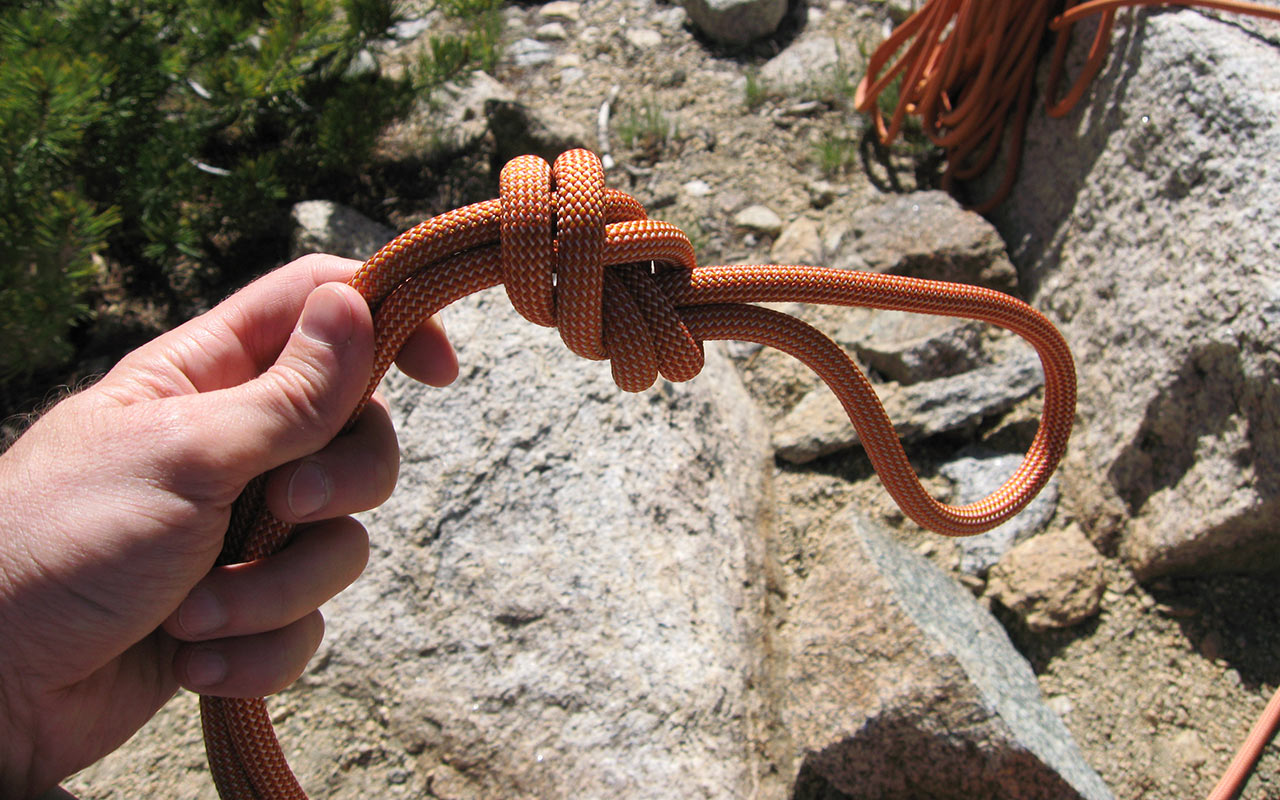
A double figure-eight knot
After a bit of wandering, we find a suitable camping spot overlooking the lake. I pay close attention as Neil unloads his backpack, wanting to see how he has stuffed his gear so neatly into a 45-liter space.
One tip: Neil has wrapped his therm-a-rest around his sleeping bag and heavily compressed both, making for a tidy package. His strategy otherwise seems to consist in just generally squashing the heck out of everything. With our tent set up and water bottles filled, it's time for a crash-course (hopefully not literally) in the essentials of technical climbing and mountaineering.
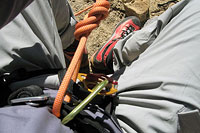
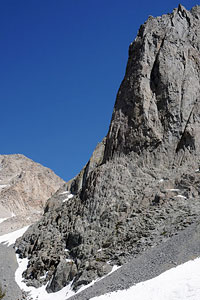
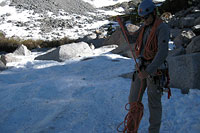
Our inaugural lesson takes place, appropriately enough, at the foot of Temple Craig's magnificent North Buttress, said to be the longest stretch of technical climbing in the High Sierra (the 'Dark Star' route).
Thanks to my own travels in the Sierra, I am no stranger to crampons and axe, but my experience ends where roped climbing begins. We are therefore embarking into a new and unfamiliar world for me—and I feel more than a little anxious about it.
We start by reviewing and putting on our harnesses.
Neil not only corrects my harness (which I've buckled the wrong way), but also teaches me a clever mnemonic which enables me to know at a glance whether my harness or his or anyone else's is correctly secured.
This seems like a good start.
On we go to the rope and a few essential knots. Neil's goal here (he later reveals) is not to cram my head full of things I'll later forget, but rather to teach me just enough to get the job done.
In this he succeeds admirably: I learn how to tie the rope to my harness, how to belay a lead climber (Neil), and a few essentials of climbing communication.
Streamlining the education process today are renegade bands of mosquitoes, who ensure that no lesson drags on longer than necessary. Soon, the sun is dropping behind the sierra's crest, and in the lengthening shadows, we decide to retreat to our tent for dinner. It strikes me, on later reflection, that most of the essentials of rock climbing are really quite simple. There are basic techniques which are employed (with modifications) over and over again.
Despite that simplicity, however, the consequences of even a minor mistake or oversight (such as my improperly-buckled harness) can be catastrophic. For that reason, it seems to me that a key aspect of technical climbing lies in developing procedures or protocols (like a pilot's checklist) designed to ensure that everything happens the same way, every time.
Then again, Neil cautions that becoming overly-focused on repeating the same procedure each time can go awry in the wrong context. His motto might be described as 'find the right solution at the right time'. After dinner we settle into our sleeping bags. Neil is soon asleep. I keep my eyes open, watching the light fade on Temple Craig, thinking of ropes and rocks and high places. Perhaps technical climbing is not so simple after all...
The Alpine Start
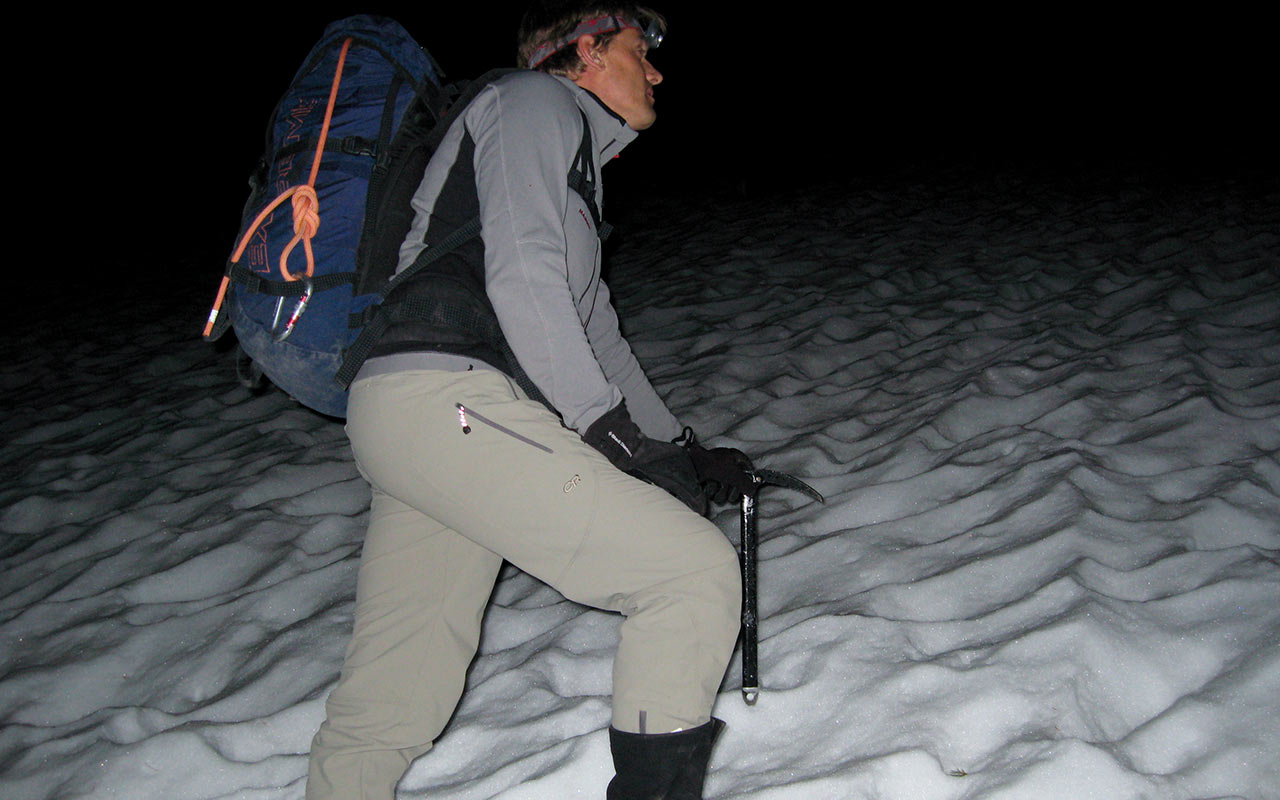
I am already awake when Neil's watch beeps at 3:30 a.m., signaling it's time for us to leave our sleeping bags. Ordinarily I am no fan of rising before the sun, but sleep has been fitful at best for me tonight.
I'm eager to switch from thinking about climbing to actually doing it. Neil boils some water for tea and a light breakfast. Twenty minutes later we've got our boots and packs on, and we're scrambling up broken granite by the light of our headlamps.
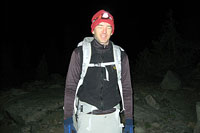
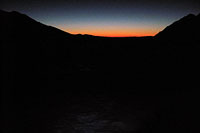
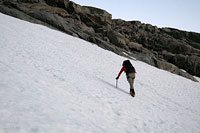
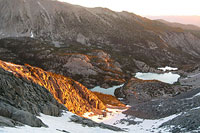
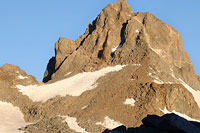
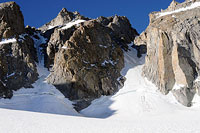
The rock soon gives way to snow. Axes in hand, we work our way up the gully. When the snow begins to steepen, we stop for a snack, and the crampons come out.
For me, climbing in soft boots and crampons (rather than ski boots) makes for much more tiring travel. I am not used to the pressure mountaineering boots put on my ankles and calves when paired with crampons.
Neil offers suggestions on how to angle my feet so as to minimize the workload. I concentrate on my footwork, trying to keep my leg muscles comfortable.
The eastern horizon begins to glow. Has so much time passed already? I sense that today will not be easy. I can't seem to find that magic rhythm of footsteps and breath.
Neil picks up the pace a bit as we pass beyond 12,000 feet, wanting to catch a view of the currently-hidden Sierra crest in the dawn's first light.
I follow, urged upward by the soon-to-be-revealed sight of the Palisade Glacier, the U-Notch Couloir, and our main objective, North Palisade itself.
At 5:56 a.m. we top the snowy gully we've been following since Third Lake, reaching Gayley Camp, elevation 12,400', and our first view of the North Palisades group. The sun glows electric-orange on the imposing granite facade of North Palisade's north face, around which crowd multiple summits above 14,000'.
Glacier travel in the Sierra is not quite the perilous undertaking one encounters in more northerly ranges (or even Mountain Shasta). Consequently we proceed unroped, though Neil notes crevasses can occasionally pop up here and there.
But first, our Glacier journey begins not on snow but rock, as we must traverse a nasty pile of talus to get to the glacier. Climbing up, over, and around these large, loose, shifting blocks is slow.
While we scrabble awkwardly across the rock in our crampons, I mentally apologize to Black Diamond as my steel points grind and protest against Sierra granite. Does this qualify, I wonder, as Mixed Climbing? With much relief, we leave the talus behind and tromp contently across the glacier's sun-cupped snow toward the U-Notch.
The sun is higher now, the day already quite warm. The sky above grows piercingly blue. Our conversation turns to skiing. In winter, I would merrily climb that beckoning couloir before us and slide down with slippery sticks attached to my feet. Today, in contrast, I will ascend and descend roped—with utmost caution.
Neil is a father of twins, and he speaks with the same limitless enthusiasm about his children as I do I about my son. This combined with Neil's dedication to not only climbing and guiding but also learning as much about the art of climbing and guiding as possible gives me strong reason to suspect he is both a conservative and passionate climber—an excellent combination in a guide.
Climbing The U-Notch
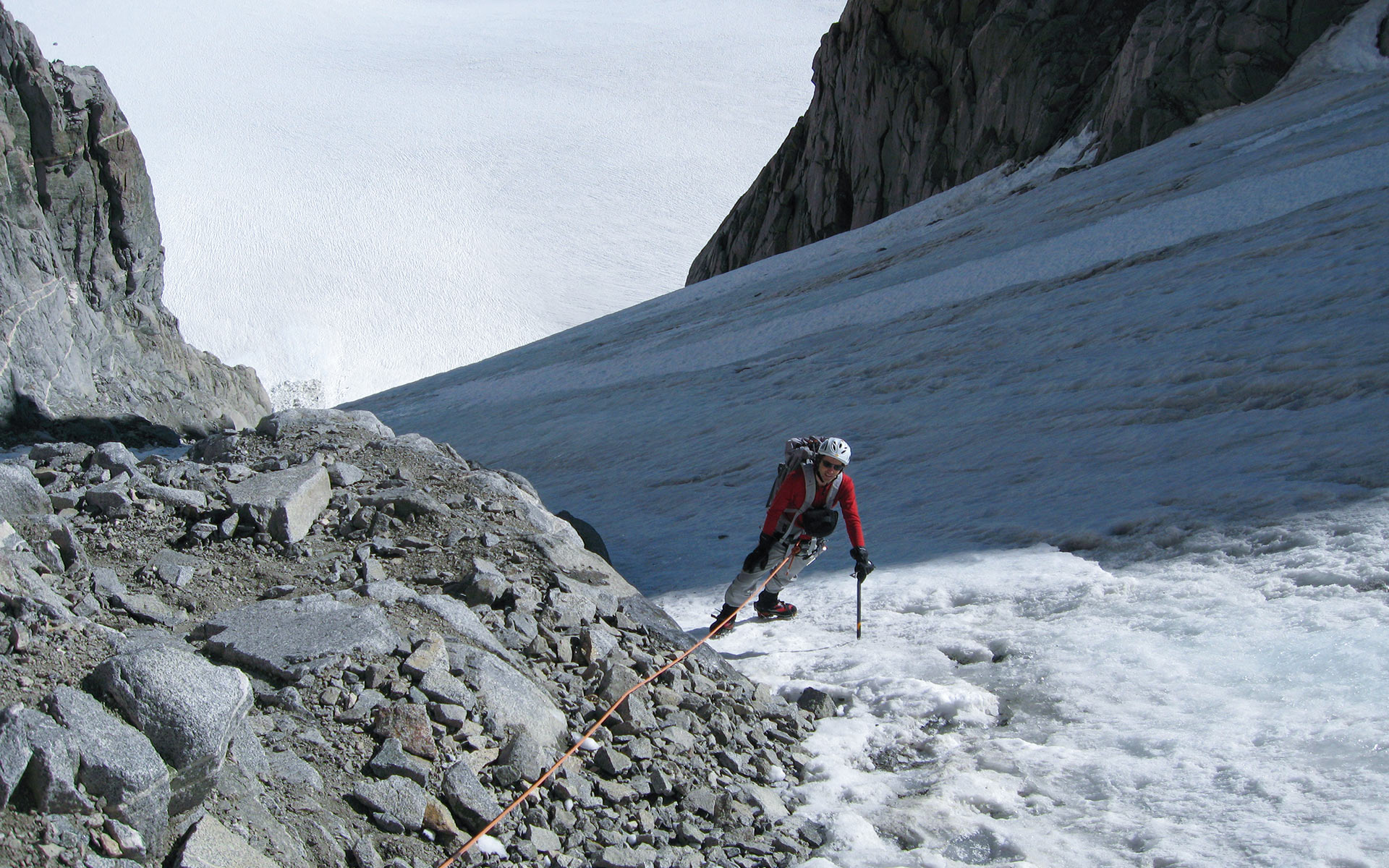
Andy climbing the U-Notch
A few hundred vertical feet below the bergschrund at the base of the couloir, Neil and I stop to put on our climbing helmets and rope up. The 'shrund (a crevasse between a glacier and a couloir) can be a formidable obstacle.
Particularly later later in the season, bergschrunds tend to open, creating significant crossing difficulties. But today there is a convenient snow bridge across thanks to the remnants of avalanche debris. We carefully work across the snow bridge, and with that barrier crossed I feel a wave of elation: I've just passed into a whole new realm of Alpine climbing.
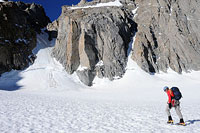
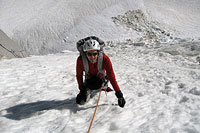
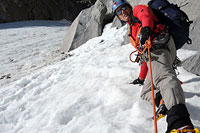
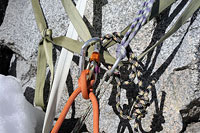
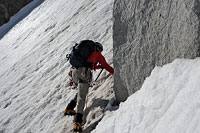
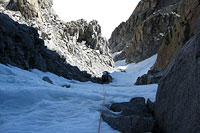
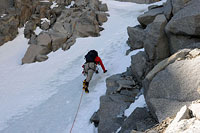
The lower part of the couloir is mostly soft snow, which we simul-climb, not stopping to secure the rope to the mountain. Soon, however, we reach a rocky buttress to the right of the couloir, where we find the first belay/rappel anchor station.
This, for the uninitiated, consists of loops of nylon webbing, age unknown, plus rappel rings (sometimes) and an occasional beater carabiner clipped and tied in various states of tangle.
Knowing how to identify good slings from bad is a fine skill to have if you're going to be trusting your life to other people's knots and hardware. I watch as Neil inspects the mess, and ask a few pointed questions of my own.
In addition to inspecting the knots, and ensuring that each has acceptably long tails of extra webbing, Neil looks to see how faded the webbing is (from sun exposure), and how worn (from rope burn, rock friction, etc).
Should the webbing strike Neil as wanting, he will replace the offending section or entire rappel sling with new webbing (something he considers part of a guide's responsibility).
He also checks to be sure that the anchoring horn of rock is not loose—seemingly a no-brainer, but one worth doing, as we'll discover later this very day.
With myself and my belay device clipped into the anchor, my job on the ascent is to feed Neil slack as he climbs upward on the Couloir's ice. In this way, if he falls, the force of the fall will be held by the anchor (not by me!), with only a minimum of slack in the system.
When Neil reaches the end of the rope, he is to shout down to me 'Off Belay', indicating that he has safely anchored himself above and no longer needs me to secure him.
At that point, I am to climb upward (shouting 'Climbing' or 'Be Dazzled by my Greatness' or some other such warning), and Neil will belay me from above in a similar manner.
Time passes. The sun grows hot on my forehead. At last, with a shout to Neil, I'm off and climbing, following behind, watching as the rope magically takes up slack above. Much of this—climbing a snowy couloir—is familiar to me, and so I feel reasonably comfortable despite the angle and exposure.
But much of what we're doing is also brand new to me, including climbing true ice and climbing on a rope. Where we encounter ice, I slow down, less sure how best to proceed. As we continue our way up the couloir, stopping here and there to clip in to a rappel station or ice screw, Neil encourages me to experiment with my technique.
Unlike solo travel, Neil points out, I have the luxury on the rope of being able to make mistakes. I do my best to take this advice to heart, trying different ways to hold my axe, different ways to position my feet. In the middle-ground soft-firmness of Alpine Boots, I find it easy to climb low angle snow and ice, but distinctly uncomfortable to climb steeper ice.
No amount of experimentation on my part relieves this equation. Occasionally, I must stand and wait on angled ice as Neil climbs, or sets a belay, or takes up slack, and these moments prove quite merciless on my leg muscles and ankles. Looking ahead to the Notch, I feel a twinge of anxiety as I contemplate what shape my calf muscles will be in for the harder climbing on rock above.
Two Pitches
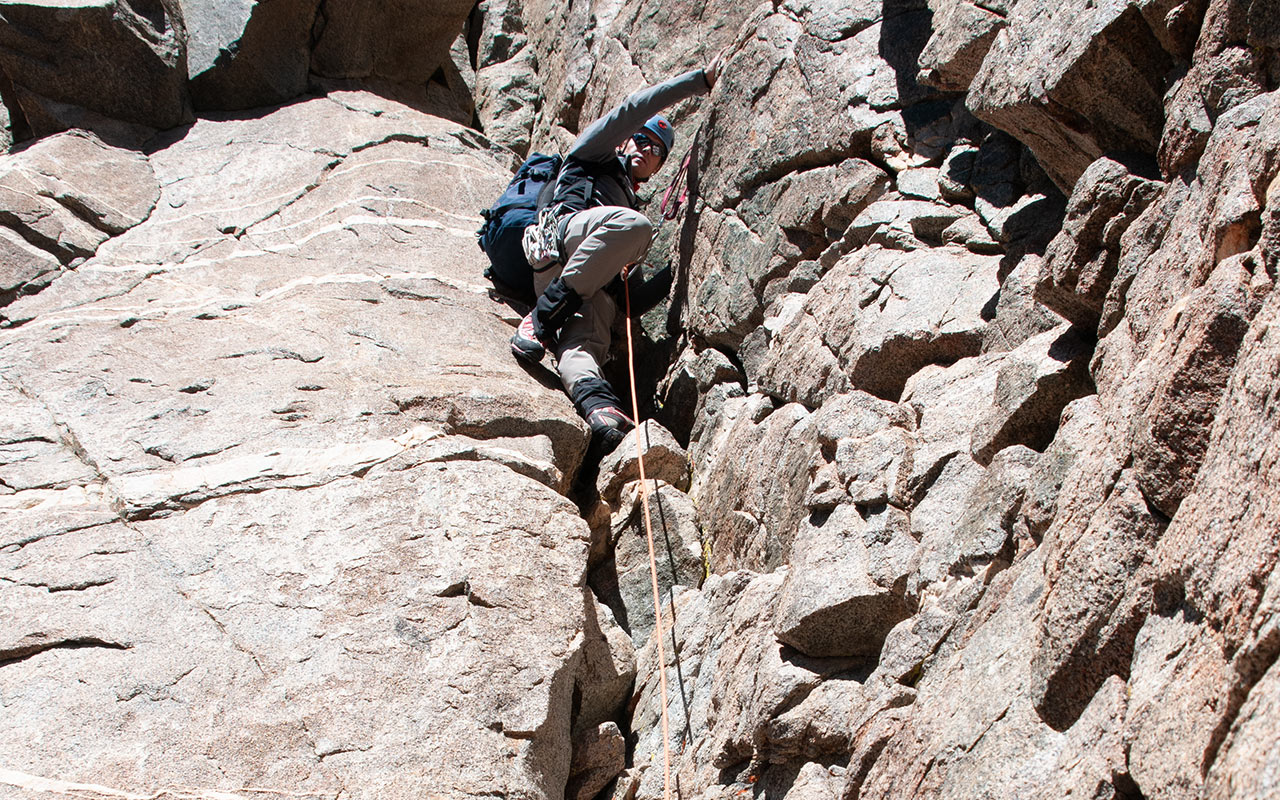
A lingering question about technical rock climbing has been on my mind for some time now (years, in fact), and at long last, as we reach the top of the U-Notch, it is about to be answered.
That question is concerned, certainly, with what I'll find in the climbing to be had above the U-Notch, but it is also very much concerned with what I'll find in myself. The chimney or corner or crack system that we will now climb is generally described as being two pitches high and of a difficulty rating between 5.2 and 5.6 on the Yosemite Decimal System.
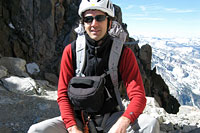
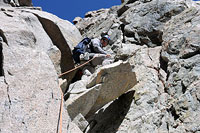
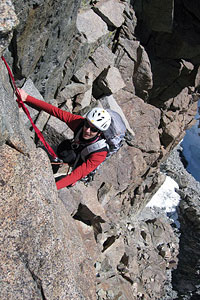
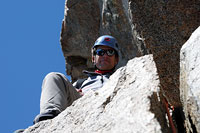
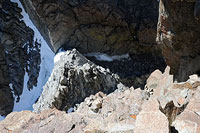
'Two Pitches,' in this context, refers to two lengths of a standard 60 meter climbing rope, equaling roughly 300 vertical feet of climbing. The precise meaning of the various delineations of Class 5 climbing is more difficult to quantify.
For years now, I have wondered what Class 5 alpine climbing looks and feels like. I have climbed Whitney via the Mountaineer's Route, Russell via the East Ridge, Williamson from the West Chute.
I have walked, climbed, skied, and scrambled all over the Southern Sierra, yet 'till this day, I have never put myself on the end of a rope at the base of a Class 5 climb and contemplated progress upward. And so I realize there are two parts to my question:
First, I quite naturally wonder whether North Palisade's two pitches will largely resemble the third and fourth class rock I've seen elsewhere—or whether it will prove to be something new entirely.
Second, in the event that in fact I'm about to enter a new realm of mountaineering, I wonder what it will feel like.
Question One answers itself as soon as I spy the continuation of our route: a vertical wall of rock towering above us, pushing up and out of sight. That wall stands as an absolute barrier to a solo Andy. Were I alone, this is the point where I'd stare dully at the rock, find a few choice curses, and then go home.
But I am not alone today.
Neil clips me to a belay anchor at the base of the climb and offers a few last-minute instructions. Just like that, he's climbing upward, and I'm feeding him slack.
The whole business, to be honest, feels a tad surreal. I am aware of the grandeur of this route, which has taken us already up the remarkable ice and snow of the U-Notch Couloir and now challenges us with bare but brightly-colored granite.
Yet also occupying my thoughts is the alarming knowledge that what goes up must also come down.
Rather than putting all our energies into getting home safely, we are instead pushing in exactly the opposite direction: higher, farther, deeper. I try to focus on the task at hand. Neil, as before, soon passes up and out of sight. I am alone at the belay station, feeding slack, watching coils of rope slowly slip upward through my belay device with a quiet, zipping sound. The full length of a rope pitch, indicated by these passing coils, is quite large, I realize.
It seems to take forever, this business of rock climbing.
And then the rope nears its end. I call a warning up to Neil: "Fifteen feet!" Some unknown time later, I hear his voice shout down to me. It's my turn. I unclip from the belay and put my hands to the rock. This much is clear right away: I have accumulated enough experience as a scrambler and a small-time boulderer to manage climbing at the 5.2-5.6 difficulty level. My confidence ticks up a tiny bit.
As I quickly gain height above the rocky ground of the Notch, I notice something else: the rope negates, at least in part, my sense of exposure. Rather than being forced to constantly peek down and assess the consequences of a mistake, I can instead ignore what is happening below and focus instead only on the rock that immediately surrounds me.
Every ten or twenty feet or so, I come across a protection piece (such as a cam or stopper) set by Neil. It is my job to remove these from the rock and clip them to my harness. Here, in these interruptions of flow, I find myself more aware of the growing void below, and I try to distract these thoughts as soon as possible by returning to the business of the rock.
The Summit Ridge
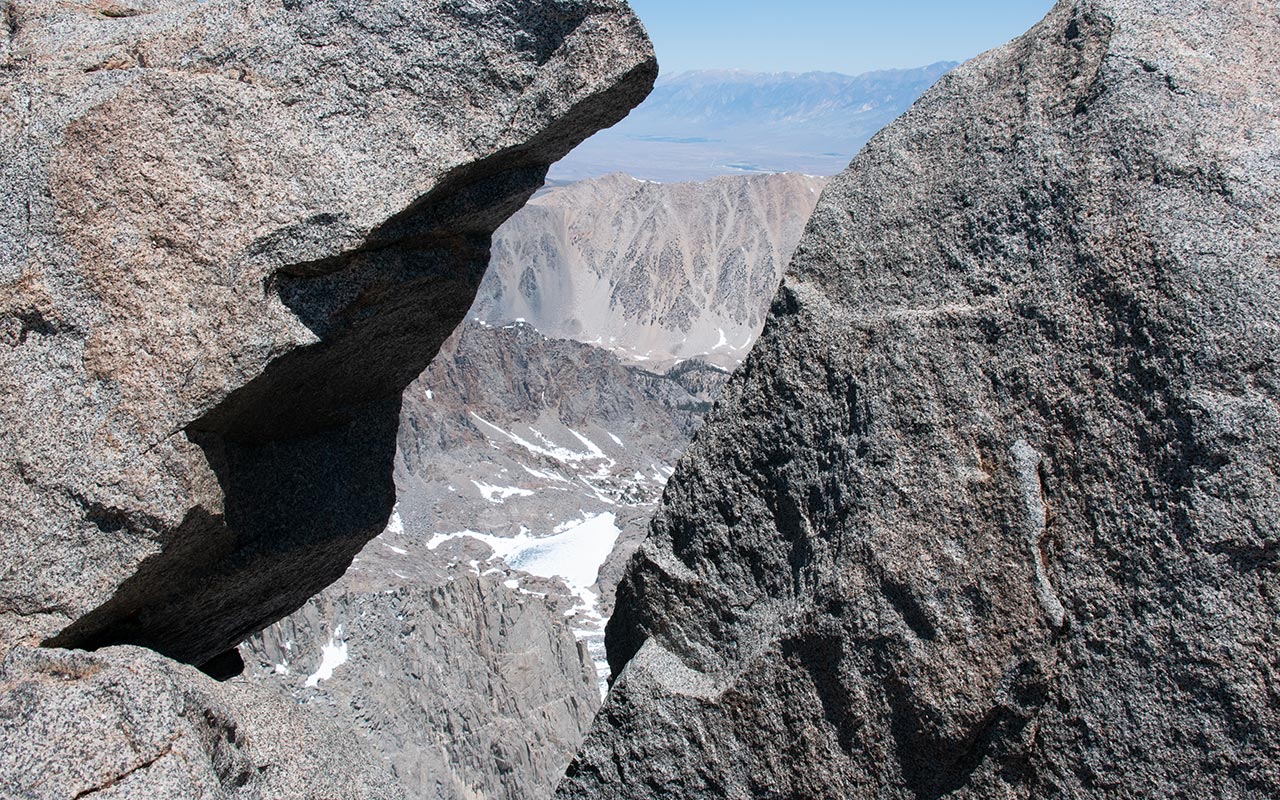
From the top of the second pitch of roped climbing, the route to North Palisade's summit is far from straightforward. More difficult climbing and route-finding remains.
Neil and I must now traverse a lengthy section of sharp ridgeline, as well as descend a bit to the southwest, into a gully system, from which we will work our way across and back up to the summit. As before, Neil leads, now belaying me not by setting protection pieces but more simply (and more conveniently) by looping coils of the rope around nearby rock horns.
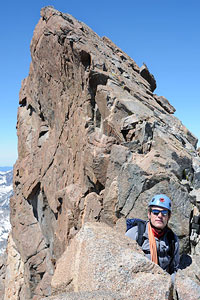
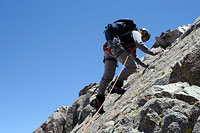
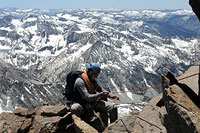
Despite the obvious exposure here, my comfort level is good. We are once again on familiar ground for me—Class 3-4 scrambling.
Though Neil recognizes the sharp rock of North Palisade's Southeast Ridge as the dangerous ground it is, to me it is not unlike other places I have soloed.
The rope thus no longer seems necessary to me (though I don't for a moment consider suggesting we climb without it), and I scramble about happily imbued with feelings of familiarity and control.
Occasionally, the climbing or the exposure gets sticky enough to warrant the rope, but this only seems to enhance my sense of security.
Each time I come to suspect we are nearing North Palisade's summit, the ridge reveals another section yet to be traversed.
Being so close to our destination, yet seemingly unable to bridge this final section, begins to wear at my patience. Eventually, we leave the ridge, heading westward into an amphitheater-like space atop the west face.
Here, the ground is loose but easy, removed from the ever-present verticality of the ridgeline.
We have now joined the upper portion of the Class 4 route up the west face (which includes climbing in the west-facing gully that joins the U-Notch). While it is considered the easiest way to the summit, the Class 4 West Face route enjoys a wide range of reputations, from being underrated to overrated to being simply impossible to find.
I would guess, should you know where you're going, that the West Face route under optimal conditions might lie within the outer margins of the ambitious scrambler's milieu. Get off route without technical climbing skills and gear, however, and I would certainly not want to part of the subsequent ordeal.
Should you get this far, be prepared for one last challenge. The headwall guarding North Palisade's summit blocks requires a bit of route finding once again, as well as a reintroduction to North Palisade's otherwise ubiquitous exposure (we in fact will rappel the headwall upon our exit rather than try to downclimb it). Neil leads the way, then belays me with the rope. I climb this section carefully, and all at once the summit reveals itself, surrounded on all sides by terrifying drops.
Atop North Palisade
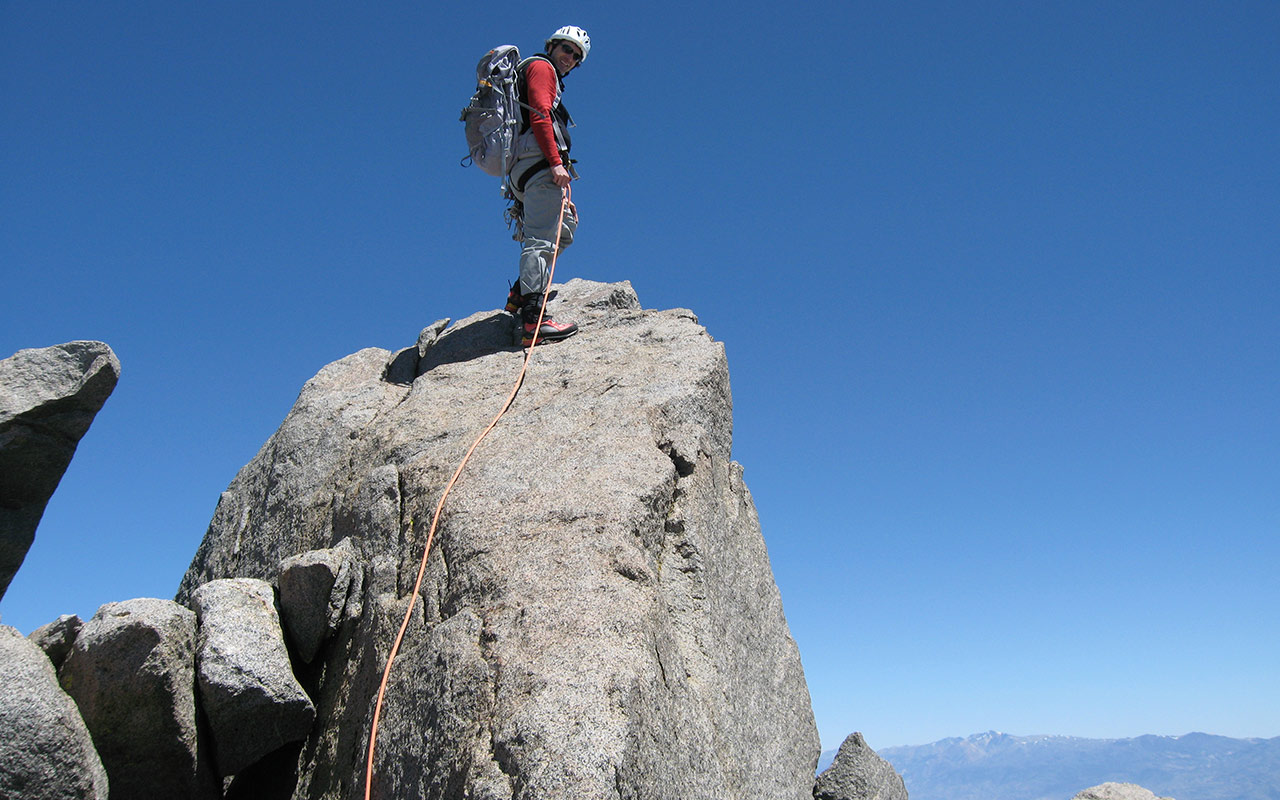
Some summits by their nature seem designed to discourage loitering, and so the apex of North Palisade seems to me as I take those final steps up its steep granite ramp.
To the east is a stunning expanse of air. Below that—far below—is the Palisade Glacier, Second Lake, First Lake. My expose-o-meter is fairly well on the fritz by now. I'm looking forward to finding a big, flat expanse of solid ground at the end of the day to cling to and perhaps cry 'Mama!' a few times or more. Neil takes a few photos of me atop North Palisade's summit block.
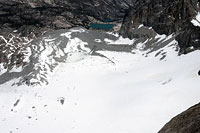
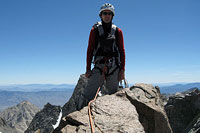
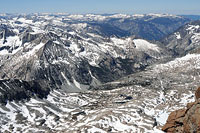
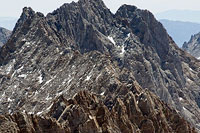
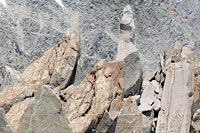
Posterity accomplished, I make no haste and meekly slink down to a nook in the rock near the USGS marker, where the call of the void is not so overpowering.
Off comes my backpack, and out comes my food and water for summit-top lunch. The time is 11:42 a.m., almost exactly eight hours since we left our camp at Third Lake.
I thank Neil for getting us, as I put it, 'Halfway there.'
But Neil will have none of this way of thinking. In his opinion, we have worked hard to get to this apex of rock, and deserve to offer ourselves a bit more congratulations than that.
Besides, he argues, we're more than halfway there in any reasonable approximation.
80% there, I ask?
Maybe a bit less than that. After a moment of discussion, we agree on an appropriate number, and congratulate each other heartily for having achieved 65% of our goal.
Meanwhile, I've recovered enough of my senses to begin to take a guarded look around. Being located in the center of the High Sierra, North Palisade's summit commands a truly remarkable view of the range.
Speaking of North Palisade's summit panorama, Sierra legend Norman Clyde wrote, "Probably the view...equals in scope and magnificence that obtained from any peak in the range and without being unusually hazardous or difficult, it is sufficiently so to render it interesting to the most skilled mountaineer."
I am particularly taken with the view of Le Conte Canyon and the Middle Fork of the Kings River, which lies due west. And then there are the fourteeners... The striking fin of Middle Palisade, 14,040' is south, just past the horn-like bulk of Mount Sill, 14,162'. Beyond that are Split Mountain, Mount Williamson, Mount Whitney, and Mount Muir.
Looking North, we see Starlight Peak almost close enough to touch, then Thunderbolt Peak, and of course White Mountain. All of these and much, much more are readily viewable from our lofty perch atop North Palisade.
The view is magnificent, but my attention is drawn elsewhere. I am thinking about what waits below: a long series of rappels to get back to the U-Notch, then another sequence of rappels to get down the couloir itself. This part of our endeavor—going down—worries me more than all other aspects combined. Rather than let my mind ponder and stew, I suggest to Neil that we get moving again. "Watch over me," I say. Neil readies the rope, and we move once again to the edge of the precipice.
On Rappel
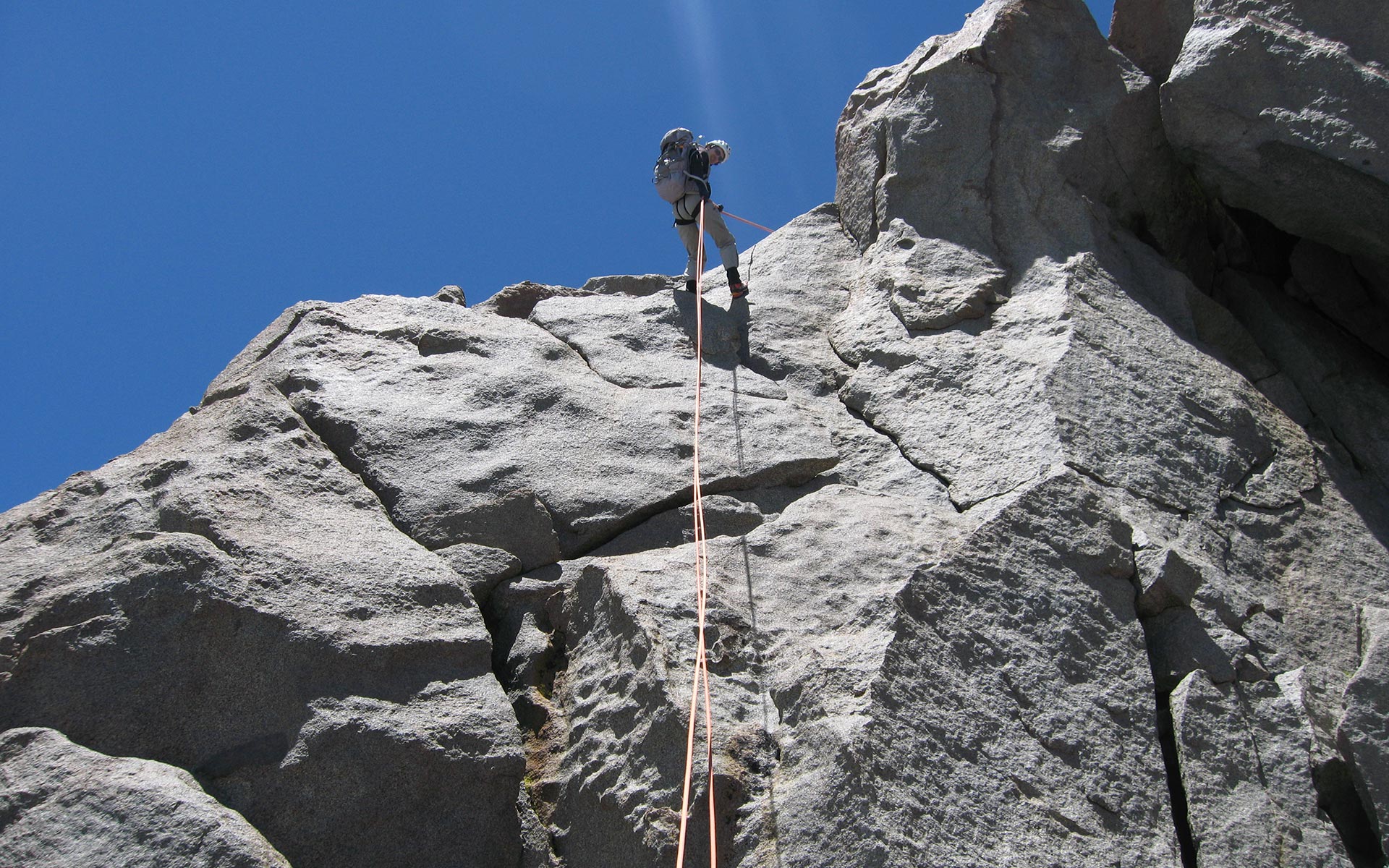
For safety, Neil will set up my rappel device, place me into position on the rope—and then go on ahead, rappelling first, so as to tension the lines for my descent.
And so I am dangling above the void. Dangling as in Christmas tree ornament, as in netless trapeze artist, as in helpless foolish pitiful human who suddenly finds himself a very long, long way from home. In mountaineering, accidents occur during the descent with far greater frequency than during ascent.
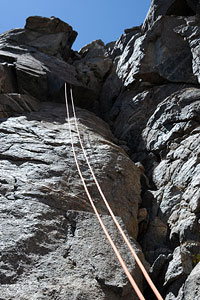
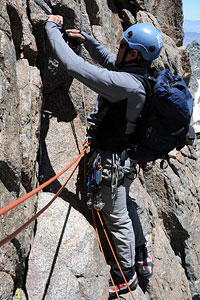
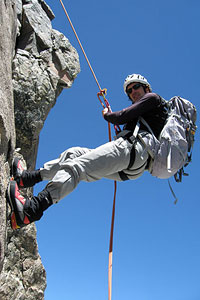
And, in mountaineering, the single most dangerous activity on descent, statistically speaking, is the rappel. Thanks to my armchair interest in studying mountaineering accidents I am aware of this fact, which seems of no good use at the moment for anything other than enhancing my sense of terror.
To be fair, however, rappel accidents happen not typically because of gear failure but rather because of technique errors.
Climbers commonly rappel off the end of their rope. They rappel with equipment they are unfamiliar with, with equipment that is worn or damaged, with ropes, anchors, or webbing that is worn or old.
Objectively speaking, these are the real dangers of rappelling—though currently my mind is not in the least interested in objectivity. No, the human animal in me points only to the yawning drop below, a hundred or more feet straight down onto sharp rocks.
Neil reaches the bottom of the rappel and shouts up to me to start down.
I feed the rope through my belay device, satisfied with the system's friction, carefully stepping backwards down a vertical rock wall. Perhaps what is so overwhelming about rappelling (to me) is the lack of wiggle room.
If I were downclimbing this rock right now (which I certainly would not wish to do), I would at least have a sense of control over my fate.
I would sense that it was up to me to pick good places to put my hands and feet. I would sense that if something were to go wrong, it might be possible, via some sort of heroics, to grab a new hold, to throw my leg thus into a crack, to maintain control.
But on rappel, all the eggs are in one basket. A failure at any point in the system equals GAME OVER regardless of heroics. We might liken rappelling to flying on a commercial airliner, and downclimbing to driving a two-lane highway.
Statistics tell us flying is safer than driving, but if things are going to go wrong, you can bet I'd rather be inside my Civic with my hand on the steering wheel than strapped into the fuselage of a Boeing 737 at 29,000 feet. My whirling mind gradually quiets as Neil and I successfully make a series of rappels. Though I cannot say I become exactly comfortable with the process, I do find a certain enjoyable fascination with it: this walking backwards straight down, this elevator-like descent.
Through it all, Neil's presence—and experience—proves to be an essential source of calm for me. Doing North Palisade not by myself nor with friends nor acquaintances but rather with a trained professional has proven its worth a thousand times over to me. In particular, climbing with an AMGA-certified guide has passed from theoretical to concrete benefit.
Since the start of this trip I have been relentlessly observing and recording everything that Neil has done. In the process of this baptism by fire, I realize now that I have gained a fine start, at least, toward my goal of learning technical alpine skills. With Neil's help, I have built a solid foundation upon which to develop future skills, if I so choose. Given everything else I've gained from this trip, it seems to me a spectacular bargain.
Downclimb
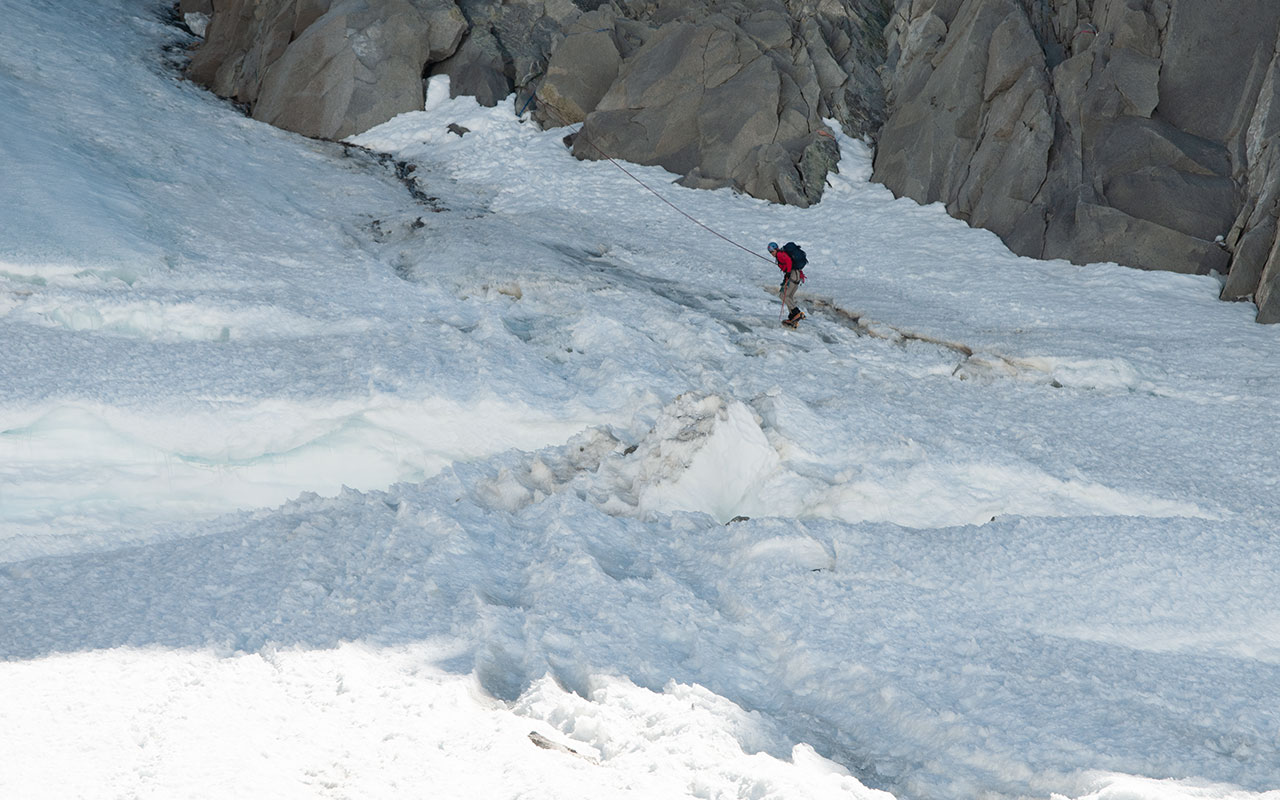
From atop the U-Notch Couloir, Neil and I have about 700 vertical feet of snow and ice to downclimb, at which point the day's technical climbing will come to an end.
Where the snow in the couloir is soft, we downclimb it, roped but not anchored, using plunge steps. Where the snow turns to ice, we rappel. As a skier, I can't help but look at downclimbing snow with a certain air of disdain, but the terrain we are traveling lies well within my skill set now (that is, off the rock), and I feel confident and content.
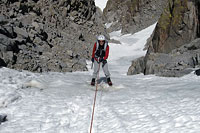
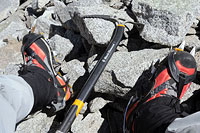
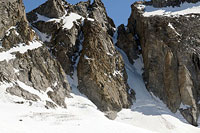
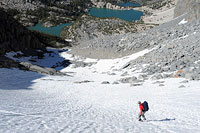
A little tired, too. In a way, I find our descent of the U-Notch Couloir perhaps the most sheer fun we've had all day. The bulk of the work is done.
Our achievement percentage has improved from 65 to now well over 90, there is no more huffing and puffing of breath, just this steady easy descent on sparkling white snow beneath a glorious Sierra blue sky.
All of these feelings (to interrupt the serenity) are exactly what make descending so dangerous. The mind and body relaxes its guard—but the exposure through this section remains considerable.
I, a skier, am especially vulnerable to this phenomenon exactly because I feel so comfortable on angles of snow.
Neil relates a story from another trip up this same couloir:
He and a party he was guiding watched a would-be skier solo up the couloir.
Midway up, the skier caught his crampon points on his ski pants and tripped. Accelerating down what was now obviously steep, hard snow, the skier tried to self arrest with an axe.
But the skier's crampon points caught once again, this time on ice, violently flipping the skier up into the air.
The skier slammed back into the snow, and yet again the crampons caught, this time stopping him at once just a few feet above the gaping bergshrund. From there, the skier downclimbed back to the glacier and (presumably) did not return.
So mind your steps, U-Notch climbers—especially as winter snow turns to glistening summer ice! Neil and I experience no such mishaps during our descent. After crossing the snow bridge across the bergshrund, we trudge downhill through sloppy-wet snow and avalanche debris until we've passed the apron of the U-Notch Couloir. Here, we are no longer exposed to falling debris from above, and so we take a break.
For the last time, I untie from the rope. We've done it—add North Palisade and the U-Notch to the list. It remains a long 2500 vertical feet or so back to camp, where we'll spend the night, but my tired legs are buoyed by the tremendous sense of accomplishment I feel.
To keep my spirits up during the long slog back to camp, Neil suggests a standing glissade competition on the steep but soft snow above Third Lake. Despite my fatigue, I do my best to Represent, going for extra style points by attempting (with some success) to figure-eight Neil's attempts to make ski turns while glissading.
Palisades Review
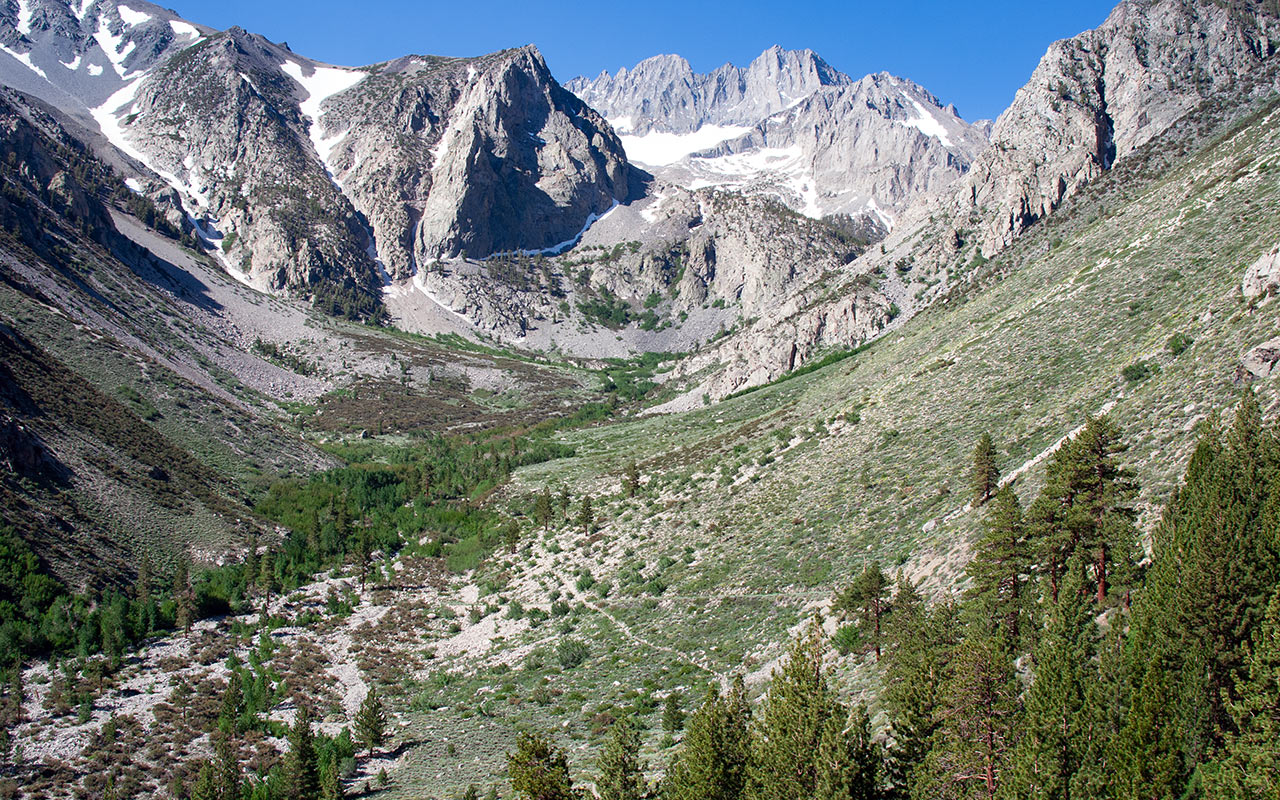
Neil and I arrive in camp as afternoon shadows push their fingers across Third Lake, signaling the end of a long but inarguably magnificent day. Neil makes a run to the lake to fill our water bottles.
I pull off my boots and socks and air out my toes. Soon, Neil and I are sitting amidst strewn climbing hardware, sipping hot drinks, sharing our perspectives on the day's adventure. For me, my brief foray into the realm of technical alpine climbing has made a lasting impression.
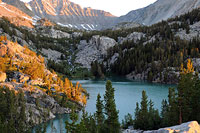
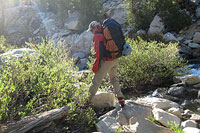
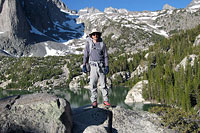
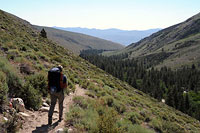
Perhaps the most surprising aspect was how natural the climbing felt. While on the rope, I felt as if in a cocoon, insulated from the world (and exposure) around me, able to focus only on the problems of ascending rock.
On the other hand, my feelings during our rappels, while not entirely unexpected, were certainly intense. Climbing ice and snow in the U-Notch Couloir was highly enjoyable for me, albeit made a bit more challenging by using Alpine boots.
I ask Neil a few questions about technique, then a few more, wanting still to soak up as much of his technical knowledge as possible. Many of the skills I've learned on this trip, I know, will prove invaluable in trips yet to come.
As for things I'd do differently...
In hindsight, it may have been prudent to pick up some technical rope skills beforehand—say, in a less committing environment. Another suggestion: you hear this every time, but, yes, I wish I had been able to arrive in better physical condition.
I had planned on doing more training hikes and exercising before this trip. Instead, I arrived in decidedly mediocre condition—by my winter standards, at least. Certainly, I wish I had been more acclimatized to the elevation.
If you live at sea level, as I do, this is largely beyond your control, though new research does suggest that camping high (ala 8000 feet or more) even once a month can confer some benefit. I felt the altitude affected me most during the first day and especially the first night at camp. Tonight I sleep much easier, watching the light slowly fade on Temple Craig's Dark Star buttress (Said Neil: it felt like Darkstar was our bedpost). The following morning we pack up early and hit the long trail home.
Much of what makes the backcountry so special is simply not readily expressible. The countless hardships and pleasures of mountain travel add up to more than their individual sum.
Crushed sandwiches and blisters and bug bites and summits and rock and snow become together something that can not be found anywhere else—something that remains with us when we return to the lowlands. Finding and sharing this gift is the what Neil's job is all about—that and getting you home safely.
SierraDescents extends a hearty Thank You! to Neil Satterfield and the entire Sierra Mountain Guides crew for an overwhelmingly positive experience—and a safe and successful summit!.